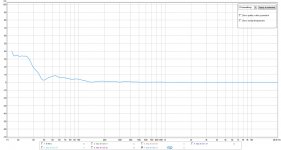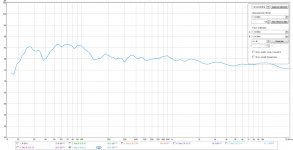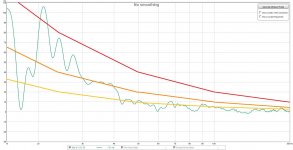Having played all morning on the issue, what i have discovered is that the only way to reduce the 40hz GD is to remove those frequencies from the FR. Any which way I try to add them, whether from mains or subs, adds the unwanted delay. Seemingly, its a room characteristic. Perhaps a room mode.
The impulse response is the fundamental data from which much can be computed thanks to Mr Fourier.
It's like saying we don't measure velocity but we measure how much time passes as a car traverses a known distance. Yet we know the velocity with great precision. We measure time ultimately. Impulse is pressure amplitude vs. time.
It's like saying we don't measure velocity but we measure how much time passes as a car traverses a known distance. Yet we know the velocity with great precision. We measure time ultimately. Impulse is pressure amplitude vs. time.
Maybe I am... Correct me if I am wrong but I think what you are saying, similar to what P10 says, is that all this is the same thing: a measurement of the frequency response, and we derive all these other things from it so it's not new information, so that we are mistaken when we think we are measuring the group delay, because it is all derived from the sweep and who knows what the real GD is... is that about right? If this is not what you mean then please explain.
Just because we measure a swept frequency, doesn't mean that the clever (and very valid) mathematics used to process that special logarithmically swept response doesn't produce an accurate impulse response, water fall plot, cumulative spectral decay, step response, and group delay. Keep in mind that the measurement may appear to be a simple sweep, but the sweep extends beyond the minimum data needed so that there is room for clever math to do sliding window algorithms that then produce things like the CSD and waterfall. But some systems actually don't sweep but record a stochastic series of impulse responses that are windowed in time.
In physics, if you can know the position at any time of any arbitrary particle, you know everything there is to know about a system (or about the universe). Because that defines the fundamental state of the universe. Everything depends on the exact location of a particle at a given time. Those locations collectively make up matter and how it is arranged. So I go back to my earlier statement about measuring the position of the car at a given time (t), you know more than the position (x), you know the speed (dx/dt), you know the acceleration (the derivative of the speed), and the jerk (the derivative of the acceleration).
With sound, if we measure the pressure at a given time, and in this case the pressure is given a special excitation so that it varies over time. We collect that pressure info as a function of time. We now know a lot of info about that speaker system because we have measured its response to a controlled stimulus.
Just because we measure a swept frequency, doesn't mean that the clever (and very valid) mathematics used to process that special logarithmically swept response doesn't produce an accurate impulse response, water fall plot, cumulative spectral decay, step response, and group delay. Keep in mind that the measurement may appear to be a simple sweep, but the sweep extends beyond the minimum data needed so that there is room for clever math to do sliding window algorithms that then produce things like the CSD and waterfall. But some systems actually don't sweep but record a stochastic series of impulse responses that are windowed in time.
In physics, if you can know the position at any time of any arbitrary particle, you know everything there is to know about a system (or about the universe). Because that defines the fundamental state of the universe. Everything depends on the exact location of a particle at a given time. Those locations collectively make up matter and how it is arranged. So I go back to my earlier statement about measuring the position of the car at a given time (t), you know more than the position (x), you know the speed (dx/dt), you know the acceleration (the derivative of the speed), and the jerk (the derivative of the acceleration).
With sound, if we measure the pressure at a given time, and in this case the pressure is given a special excitation so that it varies over time. We collect that pressure info as a function of time. We now know a lot of info about that speaker system because we have measured its response to a controlled stimulus.
Last edited:
Yes, to the extent that you can adjust time alignment up to 7ms for the 2x4 model, and I think 35ms for the 2x8 miniSHARC. It can also serve as your XO with adjustable slopes which can allow you to go to lower order filters for less phase lag/latency/delay.
Are you familiar enough with the 2x4 to know which plug-in software would work best for taking R+L fullrange inputs to drive 3 subs only
Would I still have the flexibility to use it with 2 mains and 2 subs?
Your plot of the mains only shows group delay at 40 Hz. Your subs follow in phase judging by the FR plot. As soon as you made the subs play earlier, the sum at 40 Hz was off.
Doing the same with a miniDSP isn't going to get you different summing at 40 Hz if you ask me? The delay at 40 Hz, will be partly from the ported mains / partly the room. But the subs do seem to be in phase with the mains right now.
What task would you like the miniDSP to do?
Doing the same with a miniDSP isn't going to get you different summing at 40 Hz if you ask me? The delay at 40 Hz, will be partly from the ported mains / partly the room. But the subs do seem to be in phase with the mains right now.
What task would you like the miniDSP to do?
Your plot of the mains only shows group delay at 40 Hz. Your subs follow in phase judging by the FR plot. As soon as you made the subs play earlier, the sum at 40 Hz was off.
Doing the same with a miniDSP isn't going to get you different summing at 40 Hz if you ask me? The delay at 40 Hz, will be partly from the ported mains / partly the room. But the subs do seem to be in phase with the mains right now.
What task would you like the miniDSP to do?
In one scenario, I may XO the mains higher than 40hz to minimize the GD of the mains at 40hz. And then blend in the subs.
In a second scenario, where the DSP controls only the subs, your right, that wont address the GD of the mains. But I could XO the subs even lower and/or with milder slopes, to minimize the GD the subs are adding.
I am figuring that in any case, $100 isnt a huge investment, and it gives me significantly more tools to work with.
You are missing the point!
Bob
So what is the point? Please explain.
Maybe I am... Correct me if I am wrong but I think what you are saying, similar to what P10 says, is that all this is the same thing: a measurement of the frequency response, and we derive all these other things from it so it's not new information, so that we are mistaken when we think we are measuring the group delay, because it is all derived from the sweep and who knows what the real GD is... is that about right?
If this is what Bob Brines and P10 believe the swept sine technique is about then they are plain wrong. Lots of papers have been written on the subject and it has become rather easy to explore the topic with cheap software and hardware that delivers professional results. How to interpret those measurements is a different topic.
Good read: http://audioroundtable.com/misc/Mueller.pdf
Perhaps the point is that unless measurements are done in an anechoic chamber with pro grade NIST-traceable $3k mics using $25k software packages by "professionals", don't bother talking about your stinkin' cheap mic and free software measurements? A $70 calibrated mic and free REW software has made an immense improvement in the sound quality of DIY projects.
Last edited:
Perhaps the point is that unless measurements are done in an anechoic chamber with pro grade NIST-traceable $3k mics using $25k software packages by "professionals", don't bother talking about your stinkin' cheap mic and free software measurements? Frankly, I am tired of this line by the "pros".
I agree. That line is nothing more than a text book red herring. As long as the mic is calibrated it will deliver professional results.
Predictions of GD
Here are some quick sims of the idealized system of a bass reflex and two sealed boxes using the T/S parameters (Acoustic Concepts AC10R) you provided along with the box alignments. I assumed a slightly overdamped system to extract the best transient response. Also assumed use of a 2nd order Butterworth high pass at 30Hz for the bass reflex and at 22Hz for the sealed boxes in order to keep the xmax under 7mm at 24 volts.
This is assuming no reflections or boundary effects of the room - in 4pi anechoic space.
Here is the frequency response with bass reflex (BR) only:

This is the GD for the BR only (10.5ms at 40Hz and 19.3ms at 30Hz):

Here is the frequency response of the two sealed subs:

This is the GD for the two sealed subs (9.09ms at 40Hz and 11.9ms at 30Hz):

Here is the combined frequency response for all three (only one sealed is show, overall is black):

Here is the overall GD for the whole system assuming all three subs are located at same location in space (a physical impossibility but used to show best case) the best you can get is 9.7ms at 40Hz and 15.8ms at 30Hz. It seems that combining the BR with the two sealed boxes is a good call as it brings the GD down to 15.8ms from 19.3ms if you only used the BR by itself:

If you tweak the high pass filters or remove them, you could get less GD but then max SPL will go down. I don't think 16ms GD at 30Hz is bad and that can be your goal to achieve by arrangement of locations of the subs and the filters you use, time delays etc.
I also looked at the impulse responses for both the BR and sealed cases and they look fine - with no inherent box induced delays that may require time alignment for internal propagation delay like would exist with a bass horn.
BR only IR:

Sealed only IR:

Here are some quick sims of the idealized system of a bass reflex and two sealed boxes using the T/S parameters (Acoustic Concepts AC10R) you provided along with the box alignments. I assumed a slightly overdamped system to extract the best transient response. Also assumed use of a 2nd order Butterworth high pass at 30Hz for the bass reflex and at 22Hz for the sealed boxes in order to keep the xmax under 7mm at 24 volts.
This is assuming no reflections or boundary effects of the room - in 4pi anechoic space.
Here is the frequency response with bass reflex (BR) only:

This is the GD for the BR only (10.5ms at 40Hz and 19.3ms at 30Hz):

Here is the frequency response of the two sealed subs:

This is the GD for the two sealed subs (9.09ms at 40Hz and 11.9ms at 30Hz):

Here is the combined frequency response for all three (only one sealed is show, overall is black):

Here is the overall GD for the whole system assuming all three subs are located at same location in space (a physical impossibility but used to show best case) the best you can get is 9.7ms at 40Hz and 15.8ms at 30Hz. It seems that combining the BR with the two sealed boxes is a good call as it brings the GD down to 15.8ms from 19.3ms if you only used the BR by itself:

If you tweak the high pass filters or remove them, you could get less GD but then max SPL will go down. I don't think 16ms GD at 30Hz is bad and that can be your goal to achieve by arrangement of locations of the subs and the filters you use, time delays etc.
I also looked at the impulse responses for both the BR and sealed cases and they look fine - with no inherent box induced delays that may require time alignment for internal propagation delay like would exist with a bass horn.
BR only IR:

Sealed only IR:

Attachments
-
 IR-BR-Only.png9.2 KB · Views: 333
IR-BR-Only.png9.2 KB · Views: 333 -
 GD-BR-Sealed-Sealed-All.png17.9 KB · Views: 329
GD-BR-Sealed-Sealed-All.png17.9 KB · Views: 329 -
 FR-BR-Sealed-Sealed-All.png19.6 KB · Views: 335
FR-BR-Sealed-Sealed-All.png19.6 KB · Views: 335 -
 GD-Sealed-Sealed-Only.png17.3 KB · Views: 331
GD-Sealed-Sealed-Only.png17.3 KB · Views: 331 -
 FR-Sealed-Sealed-Only.png17.9 KB · Views: 342
FR-Sealed-Sealed-Only.png17.9 KB · Views: 342 -
 GD-BR-Only.png18.1 KB · Views: 334
GD-BR-Only.png18.1 KB · Views: 334 -
 FR-BR-Only.png17.4 KB · Views: 338
FR-BR-Only.png17.4 KB · Views: 338 -
 IR-Sealed-Sealed-Only.png9.3 KB · Views: 331
IR-Sealed-Sealed-Only.png9.3 KB · Views: 331
Last edited:
- Status
- This old topic is closed. If you want to reopen this topic, contact a moderator using the "Report Post" button.
- Home
- Loudspeakers
- Full Range
- Group Delay Questions and Analysis


